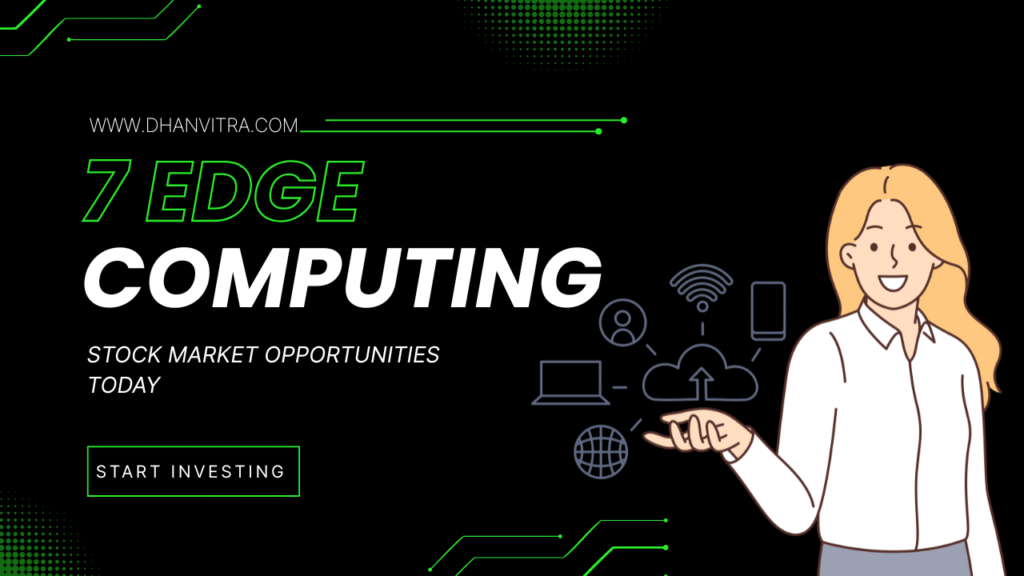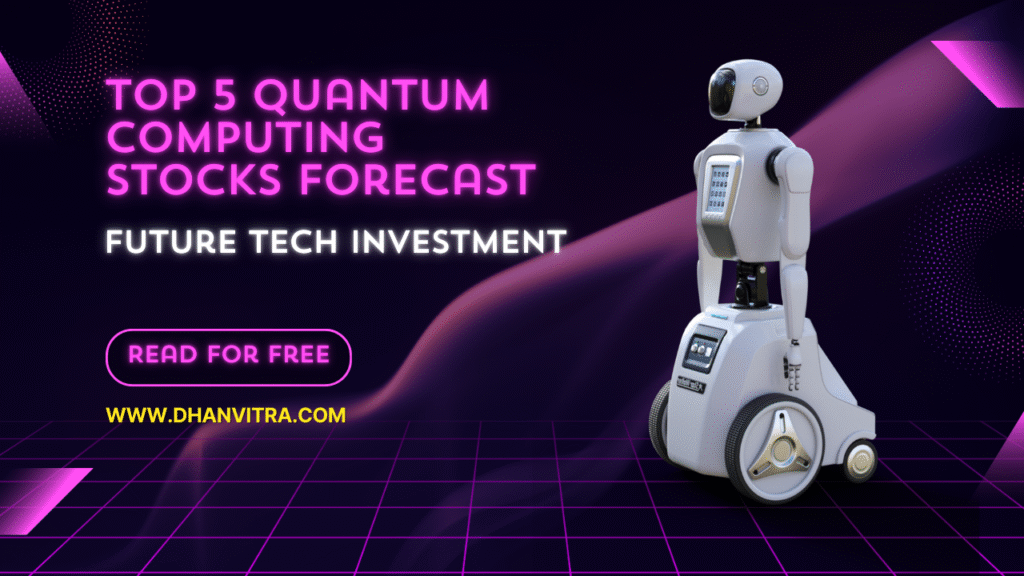
Welcome to Dhanvitra, your trusted guide to smart investing and financial growth. In today’s fast-changing world, technology is shaping the future of markets, and one innovation leading the charge is edge computing.
From powering self-driving cars to enabling smarter factories and lightning-fast 5G networks, edge computing is transforming how businesses operate and how data is processed. But here’s the real opportunity—it’s not just about technology, it’s about where the money is moving. Investors around the world are eyeing edge computing as the next big wave in the stock market.
In this blog, we’ll dive into 7 edge computing stock market opportunities you can’t afford to miss. Whether you’re a seasoned investor or just starting your investment journey, this guide will help you uncover high-growth opportunities, minimize risks, and invest with confidence.
At Dhanvitra, our mission is simple—to empower you with insights that turn market trends into profitable decisions. So, let’s get started and explore how edge computing can shape your investment portfolio today.
What is Edge Computing Stock Market?
Edge computing is one of those buzzwords that has been making headlines, but what does it really mean? Instead of sending everything across the internet to a distant data center, edge computing makes it possible to handle the heavy lifting right where the data is being generated—whether that’s in your smartphone, a factory robot, or a connected car.
This is a huge shift from the traditional cloud model, where the “brain” of operations is far away. Imagine living in New York but ordering all your groceries from a supermarket in Tokyo. It would take forever to get your essentials, right? Edge computing eliminates that waiting time by placing “mini-supermarkets” or micro data centers much closer to you. That’s why industries worldwide—from healthcare and manufacturing to retail and smart cities—are adopting this technology.
Table of Contents
Why Edge Computing is the Future
The future belongs to systems that can think and react instantly, and edge computing is built for exactly that. With billions of connected devices in our homes, offices, and cities, the demand for faster decision-making is skyrocketing. Cloud computing is still important, but it has its limits. Latency, bandwidth issues, and data security challenges often slow things down.
Edge computing solves this by creating a local brain for devices. A great example is autonomous vehicles. These cars can’t wait for instructions from a faraway data center when a pedestrian suddenly crosses the street—they need immediate responses. Similarly, in healthcare, wearable devices can track heart rates and alert doctors in real-time, potentially saving lives.
Another key factor driving the future of edge computing is 5G connectivity. With ultra-fast, low-latency networks, edge devices can communicate and process data at speeds we couldn’t even imagine a decade ago. Add artificial intelligence into the mix, and you have an unstoppable combination that will power the next wave of global innovation.
Edge Computing and Stock Market Potential
According to market research, the global edge computing market is expected to hit hundreds of billions of dollars in the next decade. This growth isn’t surprising, considering the rising number of IoT devices, the rollout of 5G infrastructure, and the need for advanced AI systems.
What does this mean for the stock market? It means investors are no longer just looking at traditional tech giants but also at companies that play critical roles in edge computing—whether that’s building chips, securing networks, or designing intelligent software. The opportunities are diverse, ranging from established multinationals to smaller innovators creating niche edge solutions.
The appeal of investing in edge computing is that it touches almost every sector: healthcare, retail, transport, logistics, manufacturing, and even energy. This wide reach makes it a global story, not just a Silicon Valley one. For investors who want to stay ahead, keeping an eye on edge computing stocks could be like spotting the early days of cloud or e-commerce—a chance to grow wealth as industries evolve.
Opportunity #1: Semiconductor Companies
At the heart of every edge device lies one crucial element: the semiconductor chip. These tiny powerhouses are the brains behind smartphones, servers, IoT devices, and AI systems. Without advanced chips, edge computing simply wouldn’t be possible.
Semiconductor companies are experiencing massive demand because edge computing requires chips that are not just powerful but also energy-efficient. Think about smart sensors in factories—they need to crunch numbers all day without overheating or draining power. That’s where innovations in semiconductors step in.
From global leaders like NVIDIA and Intel to specialized firms designing chips for IoT or AI-driven applications, semiconductor companies are well-positioned to benefit from the edge boom. They aren’t just selling hardware; they’re fueling the entire ecosystem of edge computing. For investors, this means semiconductor stocks could be the golden entry point into the world of edge.
Opportunity #2: Cloud & Edge Hybrid Providers
Edge computing doesn’t replace the cloud; instead, it complements it. Think of it as a partnership where the cloud handles large-scale processing, while the edge takes care of real-time, local tasks. Companies that can successfully blend both worlds—cloud and edge—are set to dominate the digital future.
Big tech players like Amazon Web Services, Microsoft Azure, and Google Cloud have already started integrating edge solutions into their services. By offering hybrid platforms, they give businesses the flexibility to decide what data should stay local and what should move to the cloud. This balance is crucial for industries like finance, where speed is important, but so is compliance with regulations.
For investors, these cloud-and-edge hybrids offer stability and growth. They already have global infrastructure, massive customer bases, and strong revenue streams. By adding edge capabilities, they’re expanding their market reach and creating new value. Smaller players in this space are also worth watching, especially those innovating in edge-specific software or platforms. This hybrid model is not just the future of computing—it’s the future of investing.
Opportunity #3: Telecom Giants with 5G
Telecom companies are no longer just about providing you with calls and internet data—they’ve become the architects of the next digital revolution. With the rollout of 5G networks, telecom giants hold the keys to unlocking the true power of edge computing.
5G is not just “faster internet.” It’s an infrastructure shift that reduces latency to milliseconds, enabling instant communication between machines, devices, and applications. Without this backbone, edge computing cannot thrive. Imagine a surgeon performing remote surgery or an autonomous vehicle making split-second decisions. These breakthroughs demand ultra-fast and reliable connections that only 5G-enabled telecom networks can deliver.
From an investment perspective, telecom leaders expanding their 5G infrastructure are positioned to generate massive revenue streams. They benefit not only from new consumer data demand but also from enterprise contracts with industries like manufacturing, healthcare, and logistics—all adopting edge solutions. Telecom stocks with aggressive 5G rollouts are, therefore, some of the most promising players in the edge computing space today.
Opportunity #4: Data Center REITs
Real estate meets technology in a fascinating way through Data Center Real Estate Investment Trusts (REITs). Unlike traditional REITs that focus on shopping malls or office spaces, data center REITs lease out infrastructure to cloud providers, enterprises, and telecom companies that require secure, scalable storage.
With edge computing, data centers are no longer concentrated in massive, centralized facilities. Instead, smaller, distributed edge data centers are being built closer to end-users to cut down latency and speed up processing.
For global investors, this is an attractive opportunity. Data center REITs typically generate steady cash flows through long-term leases, and now, with edge adoption accelerating, they are poised for higher growth. In essence, they represent the “picks and shovels” strategy—instead of betting on individual tech firms, you invest in the infrastructure every player needs.
Opportunity #5: Cybersecurity Leaders
As more devices, sensors, and networks connect to the edge, the risk of cyberattacks multiplies. Unlike centralized cloud systems, where security can be tightly managed, edge computing environments are decentralized and therefore more vulnerable. This makes cybersecurity one of the most critical pillars of the edge ecosystem.
Companies specializing in encryption, endpoint protection, identity management, and real-time threat detection are in high demand. Industries like healthcare, finance, and defense cannot afford downtime or breaches when dealing with sensitive data at the edge. This urgent need ensures a robust market for cybersecurity leaders who can innovate and deliver scalable protection.
For investors, cybersecurity stocks linked with edge and 5G adoption represent not just growth but also resilience. While tech trends may fluctuate, one truth remains constant—security will always be a priority.
Opportunity #6: IoT Solution Providers
Every smart watch, connected car, or industrial sensor you see is part of the Internet of Things (IoT). These devices continuously generate enormous amounts of data that must be processed instantly to be useful. Edge computing ensures that this happens smoothly.
Companies providing IoT platforms, hardware, and integration services are gaining traction as industries—from agriculture to healthcare—embrace smart solutions. For instance, a farmer using IoT-enabled sensors to monitor soil health can act in real time thanks to edge-powered analytics. Similarly, factories equipped with IoT sensors use predictive maintenance to reduce downtime and costs.
Globally, as billions of new devices come online in the next decade, the demand for scalable IoT-edge platforms will skyrocket, creating a goldmine for investors who enter early.
Opportunity #7: AI & Analytics Companies
The edge becomes truly powerful when combined with Artificial Intelligence (AI) and advanced analytics. Raw data is meaningless without intelligent processing, and that’s where AI steps in. By enabling real-time decision-making at the edge, AI transforms industries like healthcare, automotive, retail, and logistics.
Think of autonomous vehicles—they rely not just on connectivity but also on AI-driven analytics running directly on edge devices to detect obstacles and make decisions instantly. Similarly, retail stores use AI at the edge to personalize customer experiences in real time.
For investors, companies leading in AI and edge analytics represent a sweet spot: they ride on two megatrends simultaneously. Not only is the demand for AI applications growing, but the need to run them efficiently at the edge makes their solutions indispensable. Globally, this sector offers high-growth opportunities, and AI-edge synergy is set to be one of the defining investment themes of the coming decade.
Risks in Edge Computing Investments
While edge computing sounds like the golden ticket, every opportunity comes with a flip side. Investing in this space isn’t risk-free, and it’s important to understand the challenges before jumping in. The tech industry, especially emerging technologies like edge computing, tends to experience sudden ups and downs. Stocks that look promising today could lose momentum if adoption slows or new competitors enter the market.
Another challenge is technology adoption. Not every business is ready to embrace edge computing, and some industries move more slowly than others. For example, healthcare and finance are highly regulated, which can delay large-scale implementation. If adoption takes longer than expected, stock values could stagnate.
There’s also the risk of overhype. Just like we saw with the dot-com bubble, early excitement can inflate valuations. If companies fail to deliver, investors may face losses. Additionally, cybersecurity threats remain a concern. With more devices connected at the edge, the chances of breaches increase, and firms failing to secure networks could face financial setbacks.
In short, the risks revolve around timing, technology maturity, and execution. Being aware of these factors helps investors make more informed decisions rather than chasing trends blindly.
Tips to Maximize Returns
So, how do you navigate the edge computing wave and actually see profits? The first key is diversification. Instead of putting all your money into one edge computing company, spread your investments across sectors—semiconductors, telecom, AI, and cybersecurity. This reduces the chances of one bad pick wiping out your portfolio.
Another smart approach is to take a long-term perspective. Edge computing isn’t a one-year trend—it’s a multi-decade transformation. Early investors in cloud computing saw huge returns over time, and Edge could follow the same path. Patience is crucial.
Tech giants are constantly acquiring smaller startups with innovative edge solutions. Investing in companies that are either making acquisitions or positioned as takeover targets can give you an extra edge.
Lastly, never underestimate the power of research. Read company earnings reports, watch for regulatory updates, and follow market trends globally. The more informed you are, the better your chances of identifying winners before the masses do.
Global Impact of Edge Computing Investments
Edge computing isn’t just reshaping Silicon Valley; it’s a global movement. In developed markets like the United States, Europe, and Japan, edge computing is enabling smart manufacturing, autonomous driving, and advanced healthcare systems. Investors in these regions are likely to see steady growth as adoption continues.
But perhaps the most exciting story lies in emerging markets. Countries in Asia, Africa, and Latin America are experiencing rapid digital adoption. With limited infrastructure for traditional cloud computing, many of them are leapfrogging directly into edge solutions. This creates massive opportunities for companies providing affordable, scalable edge technologies.
Moreover, the 5G rollout worldwide is acting as a catalyst. As telecom providers build out networks across continents, edge computing becomes not just an option but a necessity. This global trend means investors don’t need to restrict their portfolios to one region—they can explore opportunities in diverse markets and industries.
In essence, edge computing is creating a worldwide investment landscape, offering both developed and developing nations a stake in the future of digital growth.
Conclusion
Edge computing is more than a buzzword—it’s the foundation of tomorrow’s connected world. From self-driving cars to smart cities, from IoT to AI, it sits at the heart of innovation. For investors, the opportunities are vast, but so are the risks. Success lies in balancing excitement with caution—diversifying wisely, thinking long term, and keeping an eye on global trends.
If you’re ready to future-proof your portfolio, edge computing could be your chance to invest in the next big technological revolution. The wave is here; the only question is whether you’ll ride it or watch from the shore.
FAQs
Is edge computing just another tech hype like the dot-com bubble?
Not exactly. While there is hype, edge computing is rooted in real-world applications like autonomous vehicles, IoT, and 5G. Unlike the dot-com bubble, this is a technology already in use across industries, though valuations can sometimes outpace reality.
Which fields will experience the most significant benefits from edge computing?
Industries like telecom, manufacturing, healthcare, automotive, and logistics are at the forefront. These sectors need real-time data processing and will likely drive adoption the fastest.
Should beginners invest in edge computing stocks?
Yes, but with caution. Beginners should start small, diversify, and avoid investing money they can’t afford to lose. Consider ETFs that cover multiple tech stocks if you’re unsure about picking individual winners.
How soon can investors expect returns from edge computing stocks?
It depends on the company and market. Some firms may deliver short-term gains, but most edge computing opportunities are long-term plays, with real growth potential unfolding over the next 5–10 years.
Is edge computing only relevant in developed countries?
No, it’s global. In fact, emerging markets are adopting edge solutions quickly, often faster than developed countries, because they can bypass outdated infrastructure and move directly to modern networks.










The surge in edge computing stocks is really exciting! 🌐 It’s amazing how this technology is transforming industries. Looking forward to what’s next!
Exciting times for edge computing! 🌟 The stock market is buzzing with opportunities. Can’t wait to see how these companies innovate and grow! 📈
I love seeing the potential in edge computing stocks right now! It’s such a game-changer for tech. Who else is keeping an eye on these trends? 🤔💡
So many promising edge computing stocks popping up today! It feels like a great time to invest in tech that’s shaping our world. What are your thoughts? 💬
Edge computing is definitely the future, and it’s thrilling to see the stock market reflecting that! 🚀 Anyone have favorite stocks they’re watching? Let’s share insights!